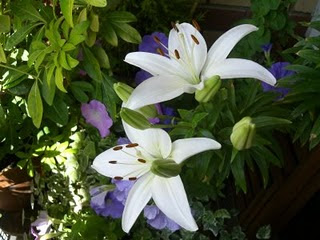
I have clearly been guilty of far more procrastination than planting, since my records indicate my last post to the London Vegetable Garden was on October 11th! Although the winter months are barren, my barren blogging spell has in fact been down to a number of reasons: hectic periods at work and home, coupled with the fact that I had to give up the allotment in November.
Those of you who remember the move to the allotment in April will also remember that I was there under grace and favour. Two kind elderly women allowed me to use part of their huge allotment free of charge, since they were struggling to cope with such a vast plot. Continuing that sentiment, it transpired in November that they were going to reduce the size of their allotment to a piece they could manage, which obviously meant releasing half of it back to the council, through official channels. This, in turn, meant that my enjoyable holiday on the allotment had officially come to an end.
Whilst this was a blow, I always knew that I was enjoying a very lucky situation, as well as knowing my fiancé and I would be moving away from Richmond come the springtime. So in retrospect, what have I learned from 7 months out in the open, gardening and growing vegetables in an allotment? After all, a year ago, I was growing crops in pots on a balcony!
PEST CONTROL
For me, one of the biggest learning curves was the sudden problem of pests and gardening in the exposed outdoors! My initial naivety saw baby seedlings quickly eaten up by pigeons; snails consume great swathes of lettuces; wind knock down runner bean poles. As much as one works 'with' nature when growing vegetables, one is also constantly battling it.
CARROTS REMAIN AN ENIGMA
Despite claims that varieties of carrots can be grown in deep pots, I had no success on my balcony. This year, I discovered that carrots are also extremely difficult to cultivate in stony soil. Perhaps it was the variety I used; perhaps the location I planted them. But one thing's for certain – carrots are not good to me!
SOIL PREPARATION
For me, working the soil was ultimately one of the most eye-opening experiences of having an allotment. The days of filling balcony-sized pots with bags of nicely sieved compost are long gone and hard physical work was needed to till the soil and make it hospitable for plants and seeds. Picking out stones, breaking up clods of dry earth – I'm sure many of you can sympathise.
PROXIMITY IS PARAMOUNT
I lived about 2 miles from my allotment and used to run up there. In the summer this is wonderful – finish work, run up to the allotment and potter about. However, it soon becomes a chore to plan trips of this distance, as well as logistically difficult if one needs to carry / things / take things / forgets things (I'm not a car driver)! I would say that being close to your allotment is vital for ease of access and motivation. The summer months are hectic and a few days without visiting results in a messy allotment and a lot of work.
GARDENERS ARE SOCIAL
I was lucky enough to regularly see some lovely chaps on the allotments around mine. Their experience and advice was greatly experienced – it's this passing down of knowledge that not only makes gardening such a social pastime, but also makes one think about the wider social picture. I learnt a lot of tips from these chaps, Colum especially, so allotments are a gold-mine of friendly and experienced people – make sure you pick their brains!
AN ALLOTMENT BEARS HARVEST
If you can be bothered to trawl through this blog's archives, you can see that I managed to produce lots of tomatoes, runner beans and lettuce leaves on my balcony. An allotment is a different ball game however. The room, space and depth of soil allows you to really plant things that will grow fantastically and at some stages in the summer, I was coming home with regular loads of booty. And this was only on a patch of a shared allotment – if carefully planned, a whole allotment really could feed a family fro several weeks.
GROWING VEGETABLES IS REWARDING
There's no doubt that the placidity, calm and enjoyment from allotment gardening is immense. I plan to write a post soon entitled 'Why I Dig', explaining the various forms of enjoyment one gets through gardening. But it really is fantastically enjoyable, as well as rewarding.
***
It's been a wonderful experience and I know that 2011 holds even more exciting treats in store. There is a possible relocation up north to happen, which would involve looking at a house with a garden. The London Vegetable Garden will be on the move once again – and the name may have to be re-thought a little! But the determination to garden, grow and cultivate remains stronger than ever.
Callum













